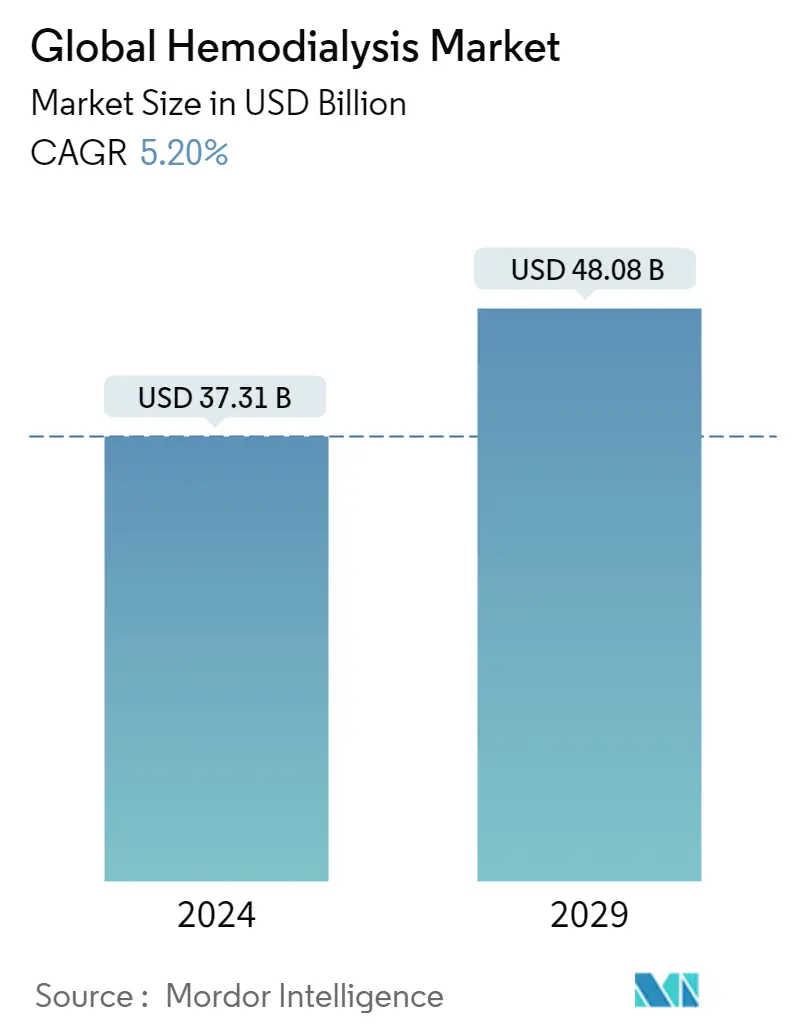Market Size of Global Hemodialysis Industry

| Study Period | 2019 - 2029 |
| Market Size (2024) | USD 37.31 Billion |
| Market Size (2029) | USD 48.08 Billion |
| CAGR (2024 - 2029) | 5.20 % |
| Fastest Growing Market | Asia Pacific |
| Largest Market | North America |
| Market Concentration | High |
Major Players
*Disclaimer: Major Players sorted in no particular order |
Hemodialysis Market Analysis
The Global Hemodialysis Market size is estimated at USD 37.31 billion in 2024, and is expected to reach USD 48.08 billion by 2029, growing at a CAGR of 5.20% during the forecast period (2024-2029).
The COVID-19 pandemic had a substantial influence on the healthcare systems, with serious ramifications for both COVID-19-infected patients and non-patients, leading to the cancellation of diagnostic and treatments. The government's restrictions to prevent the spread of the coronavirus among people have lowered the demand for treatment services for chronic diseases such as kidney disease, diabetes, and hypertension, leading to the closure of healthcare clinics, and hospitals. This restricted the diagnosis and treatment of patients with chronic kidney diseases and hampered market expansion. For instance, according to an article published by Elsevier in Kidney International Reports, in September 2020, titled 'The Adverse Effect of COVID Pandemic on the Care of Patients With Kidney Diseases in India', the availability of consumables for hemodialysis and peritoneal dialysis and essential medicines were affected by the lockdown across the globe. The total number of patients on regular dialysis decreased from 2517 to 2404 (from 972 to 928 in public and from 1545 to 1476 in the private sector). In addition, as per the same source,28.2% of patients missed 1 or more sessions of dialysis during the initial 3 weeks of lockdown and the treating nephrologists advised an additional 77 patients (47 in the public and 30 in the public sectors) to reduce their frequency of dialysis to accommodate potential dialysis requirements for COVID-19-positive patients and limitations imposed by the hospitals. Thus, the lack of availability of dialysis services in the public and private hospitals has severely impacted the patients, thus impacting the market growth.
However, the people affected by the COVID-19 pandemic were found to develop kidney diseases and other chronic conditions. For instance, according to an article published by Johns Hopkins University, in March 2022, titled 'COVID-19 Impact on Patients with Kidney Disease', it has been observed that the people infected with COVID-19 showed signs of kidney damage, and even those with no prior kidney problems were infected with the kidney disease. The rising risk of developing chronic kidney diseases and acute kidney injury among patients is likely to increase the demand for hemodialysis, thereby boosting the market growth.
Certain factors that are propelling the market growth are the rising number of end-stage renal diseases and increasing incidences of diabetes and hypertension among the population. For instance, according to the 2020 report of the International Society of Nephrology (ISN), kidney disease affects approximately 850 million population globally in 2020 and as per estimates, one in ten adults has chronic kidney disease (CKD). Further, as per the same source, the global burden of CKD is continuously increasing and is projected to become the 5th most common cause of years of life lost globally by 2040. Thus, the increasing burden of kidney diseases is expected to rise the market growth.
The increasing prevalence of hypertension and diabetes among the population is increasing the risk of developing kidney disease and kidney failure. Diabetic nephropathy is a common complication of type 1 and types 2 diabetes, as the blood vessel clusters in the kidney may get damaged, by the high blood glucose level in the patient, which helps in filtering the waste from the body and results in the renal damage. For instance, according to the 2022 statistics published by the International Diabetes Federation in the 10thedition of 2021, in Spain, 5,141.3 thousand people are living with diabetes, in 2021. In addition, as per the same source, this number is projected to reach 5,576 thousand by 2030 and 5,647.6 thousand by 2050. Also, as per the same source, 6,199.9 thousand people are living with diabetes, in 2021, in Germany. In addition, as per the same source, this number is projected to reach 6,519.7 thousand by 2030.
Furthermore, according to an article published by Clinical hypertension journal, in February 2021, titled 'Prevalence, awareness, treatment, and control of hypertension in Nigeria in 1995 and 2020: A systematic analysis of current evidence', it has been observed that 27.5 million people in Nigeria was having hypertension in 2020. In addition, as per the same source, about 29.0% of cases were aware that they had hypertension, 12.0% were receiving treatment, and 2.8% had blood pressure that was within the target range, in 2020, in Nigeria. Thus, the increasing burden of diabetes and hypertension among the population is expected to increase the risks of developing kidney diseases by narrowing the arteries and decreasing the blood flow to the kidneys, which is expected to increase the demand for hemodialysis treatment, thereby boosting the market growth.
However, the risks and complications associated with dialysis are expected to restrain the market growth.
Hemodialysis Industry Segmentation
As per the scope of this report, Hemodialysis is a process where the blood is cleaned using a dialysis machine by using a specific filter called an artificial kidney, or a dialyzer. Hemodialysis helps regulate vital blood minerals like potassium, salt, and calcium as well as blood pressure. The Hemodialysis Market is Segmented by Product Type (Equipment and Consumables), Modality (Conventional Long-term Hemodialysis, Short Daily Hemodialysis, and Nocturnal Hemodialysis), and Geography (North America, Europe, Asia Pacific, Middle-East, and Africa, and South America). The market report also covers the estimated market sizes and trends for 17 different countries across major regions, globally. The report offers the value (in USD million) for the above segments.
| By Product Type | |||||
| |||||
|
| By Modality | |
| Conventional Long-term Hemodialysis | |
| Short Daily Hemodialysis | |
| Nocturnal hemodialysis |
| By Geography | ||||||||
| ||||||||
| ||||||||
| ||||||||
| ||||||||
|
Global Hemodialysis Market Size Summary
The hemodialysis market is poised for significant growth over the forecast period, driven by the increasing prevalence of chronic kidney diseases, diabetes, and hypertension. The market's expansion is influenced by the rising number of end-stage renal disease cases and the growing incidence of diabetes and hypertension, which are key risk factors for kidney disease. The COVID-19 pandemic has had a profound impact on healthcare systems, affecting the availability of dialysis services and leading to a temporary decline in patient numbers. However, the pandemic also highlighted the vulnerability of patients to kidney damage, potentially increasing the demand for hemodialysis. Innovations such as home and mobile dialysis services are expected to further boost market growth by improving accessibility and convenience for patients.
North America is anticipated to dominate the hemodialysis market, supported by a well-established healthcare infrastructure and high healthcare spending. The region's aging population, coupled with the rising prevalence of chronic diseases, is expected to drive demand for dialysis procedures. The market is characterized by moderate consolidation, with key players like Fresenius Medical Care, Baxter International, and DaVita Inc. leading the charge in developing advanced dialysis technologies. Strategic partnerships and innovations in dialysis equipment are expected to enhance patient outcomes and drive market growth. Overall, the hemodialysis market is set to experience robust growth, fueled by increasing patient needs and technological advancements.
Global Hemodialysis Market Size - Table of Contents
-
1. MARKET DYNAMICS
-
1.1 Market Overview
-
1.2 Market Drivers
-
1.2.1 Rising Number of End Stage Renal Disease Patients
-
1.2.2 Increasing Incidence of Diabetes and Hypertension
-
-
1.3 Market Restraints
-
1.3.1 Risks and Complications Associated with Dialysis
-
-
1.4 Industry Attractiveness - Porter's Five Forces Analysis
-
1.4.1 Bargaining Power of Buyers/Consumers
-
1.4.2 Bargaining Power of Suppliers
-
1.4.3 Threat of New Entrants
-
1.4.4 Threat of Substitute Products
-
1.4.5 Intensity of Competitive Rivalry
-
-
-
2. MARKET SEGMENTATION (Market Size by Value in USD million)
-
2.1 By Product Type
-
2.1.1 Equipment
-
2.1.1.1 Dialysis Machines
-
2.1.1.2 Hemodialysis Water Treatment Systems
-
2.1.1.3 Other Hemodialysis Equipment
-
-
2.1.2 Consumables
-
2.1.2.1 Dialyzers
-
2.1.2.2 Catheters
-
2.1.2.3 Other Hemodialysis Consumables
-
-
-
2.2 By Modality
-
2.2.1 Conventional Long-term Hemodialysis
-
2.2.2 Short Daily Hemodialysis
-
2.2.3 Nocturnal hemodialysis
-
-
2.3 By Geography
-
2.3.1 North America
-
2.3.1.1 United States
-
2.3.1.2 Canada
-
2.3.1.3 Mexico
-
-
2.3.2 Europe
-
2.3.2.1 Germany
-
2.3.2.2 United Kingdom
-
2.3.2.3 France
-
2.3.2.4 Italy
-
2.3.2.5 Spain
-
2.3.2.6 Rest of Europe
-
-
2.3.3 Asia Pacific
-
2.3.3.1 China
-
2.3.3.2 Japan
-
2.3.3.3 India
-
2.3.3.4 Australia
-
2.3.3.5 South Korea
-
2.3.3.6 Rest of Asia Pacific
-
-
2.3.4 Middle-East and Africa
-
2.3.4.1 GCC
-
2.3.4.2 South Africa
-
2.3.4.3 Rest of Middle-East and Africa
-
-
2.3.5 South America
-
2.3.5.1 Brazil
-
2.3.5.2 Argentina
-
2.3.5.3 Rest of South America
-
-
-
Global Hemodialysis Market Size FAQs
How big is the Global Hemodialysis Market?
The Global Hemodialysis Market size is expected to reach USD 37.31 billion in 2024 and grow at a CAGR of 5.20% to reach USD 48.08 billion by 2029.
What is the current Global Hemodialysis Market size?
In 2024, the Global Hemodialysis Market size is expected to reach USD 37.31 billion.

